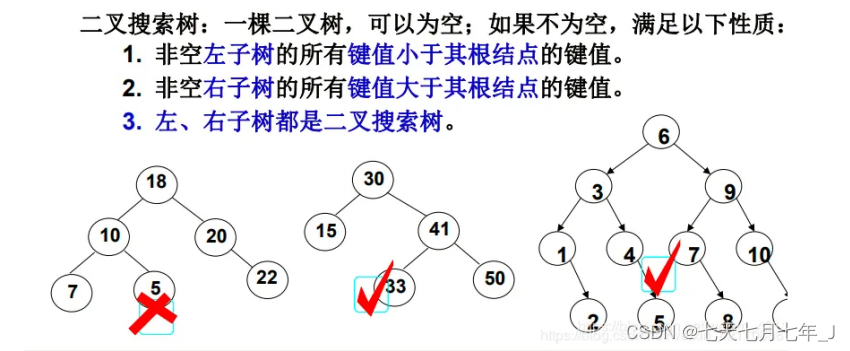二叉搜索树(BSTree)

目录
一、二叉搜索树
二、二叉搜索树的接口及实现
1、二叉搜索树的查找
2、二叉搜索树的插入
3、二叉搜索树的删除
三、二叉搜索树的递归版本
本期博客主要分享二叉搜索树的底层实现。(主要是笔记,供自己复习使用😂)
一、二叉搜索树
二叉搜索树(BST,Binary Search Tree)又称二叉排序树,它或者是一棵空树,或者是具有以下性质的二叉树:
若它的左子树不为空,则左子树上所有节点的值都小于根节点的值。
若它的右子树不为空,则右子树上所有节点的值都大于根节点的值。
它的左右子树也分别为二叉搜索树。

二、二叉搜索树的接口及实现
1、二叉搜索树的查找
a、从根开始比较,查找,比根大则往右边查找,比根小则往左边走查找。
b、最多查找高度次,如果走到空,还没找到,这个值在树中不存在。
代码实现:
bool Find(const K& key){Node* cur = _root;while (cur){if (key < cur->_key){//去左树cur = cur->_left;}else if (key > cur->_key){//去右树cur = cur->_right;}else{//找到了return true;}}return false;}2、二叉搜索树的插入
a、树为空,则直接新增节点,赋值给root指针
b、树不空,按二叉搜索树性质查找插入位置,插入新节点。
代码实现:
//插入bool Insert(const K& key){if (_root == nullptr){_root == new Node(key);return true;}Node* cur = _root;Node* parent = nullptr;//查找插入位置while (cur){if (cur->_key < key){//去右树parent = cur;cur = cur->_right;}else if (cur->_key > key){//去左树parent = cur;cur = cur->_left;}else{//相等return false;}}//找到插入位置//判断我是左子还是右子//因为cur为空,所以要根据值来判断cur = new Node(key);if (key < parent->_key){parent->_left=cur;}else{parent->_right=cur;}return true;}3、二叉搜索树的删除
删除比较麻烦。我们要对它的几种情境进行分析。
a、要删除的节点无孩子节点
b、要删除的节点只有左孩子节点
c、要删除的节点只有右孩子节点
d、要删除的节点有左、右孩子节点
实际情况a可以和情况b或者情况c一块处理。如果右孩子为空,则托孤给父亲节点它的左孩子。如果左孩子为空,则托孤给父亲节点它的右孩子。如果左右孩子都不为空,则要找替换节点。
替换规则:
找右子树的最左节点(右子树值最小),或者找左子树的最右节点(左子树值最大)与要删除节点替换。目的是为了满足根大于左子树而小于右子树。
代码:
bool Erase(const K& key){//左孩子为空Node* cur = _root;Node* parent = nullptr;while (cur){if (cur->_key < key){//key大于_key--去右子树查找parent = cur;cur = cur->_right;}else if (cur->_key > key){parent = cur;cur = cur->_left;//左子树}else{//找到了//分为三种情况if (cur->_left == nullptr){//左孩子为空//托孤右孩子//判断cur是parent左孩子还是右孩子if (cur == _root)//考虑删根的情况{_root = cur->_right;}else{if (cur == parent->_left){parent->_left = cur->_right;}else{//cur是右孩子parent->_right = cur->_right;}}delete cur;}else if (cur->_right == nullptr){//右为空--托孤左孩子if (cur == root){_root = cur->_left;}else{if (cur == parent->_left){parent->_left = cur->_left;}else{//cur是右孩子parent->_right = cur->_left;}}delete cur;}else{//左右都不为空Node* minRight = cur->_right;//找右子树的最左节点parent = cur;while (minRight->_left){parent = minRight;minRight = minRight->_left;}cur->_key = minRight->_key;//最左节点,不可能有左孩子,只可能有右孩子if (minRight == parent->_left){parent->_left = minRight->_right;}else{parent->_right = minRight->_right;}delete minRight;}return true;}}return false;}以上是循环版本主要接口的实现。而二叉搜索树递归版本也是非常有趣的。
三、二叉搜索树的递归版本
template<class K>struct BSTreeNode{BSTreeNode<K>* _left;BSTreeNode<K>* _right;K _key;BSTreeNode(const K& key):_left(nullptr),_right(nullptr),_key(key){}};template<class K>class BSTree{typedef BSTreeNode<K> Node;public:BSTree():_root(nullptr){}BSTree(const BSTree<K>& copyt){//拷贝构造_root = Copy(copyt._root);}BSTree<K>& operator=(BSTree<K> t){swap(_root, t._root);return *this;}~BSTree(){Destory(_root);_root = nullptr;}void InOrder(){_InOrder(_root);cout << endl;}bool FindR(const K& key){return _FindR(_root, key);}bool InsertR(const K& key){return _InsertR(_root, key);}bool EraseR(const K& key){return _EraseR(_root, key);}private:bool _InsertR(Node*& root, const K& key){if (root == nullptr){root = new Node(key);return true;}if (root->_key < key){return _InsertR(root->_right, key);}else if (root->_key > key){return _InsertR(root->_left, key);}elsereturn false;}bool _FindR(Node* root, const K& key){if (root == nullptr)return false;if (key > root->_key){//右子树return _FindR(root->_right, key);}else if (key < root->_key){return _FindR(root->_left, key);}elsereturn true;}bool _EraseR(Node*& root, const K& key){if (root == nullptr){return false;}if (root->_key < key){return _EraseR(root->_right,key);}else if (root->_key > key){return _EraseR(root->_left, key);}else{//找到要删除的节点//替换删除?if (root->_left == nullptr)root = root->_right;else if (root->_right == nullptr)root = root->_left;else{//左右都不为空//找左子树的最右节点,或者右子树的最左节点Node* minRight = root->_right;while (minRight->_left){minRight = minRight->_left;}//左为空swap(root->_key, minRight->_key);//交换值后转换成在子树中去删除节点return _EraseR(root->_right, key);}delete del;return true;}}Node* Copy(Node* root){//前序遍历if (root == nullptr)return nullptr;Node* newRoot = new Node(root->_key);newRoot->_left = Copy(root->_left);newRoot->_right = Copy(root->_right);return newRoot;}void Destory(Node* root){if (root == nullptr)return;Destory(root->_left);Destory(root->_right);delete root;}void _InOrder(Node* root){//根左右if (root == nullptr)return;_InOrder(root->_left);cout << root->_key << " ";_InOrder(root->_right);}Node* _root;};递归版本实现非常巧妙的地方在于插入接口和删除接口的实现:
他们使用的是root地址的引用而不是地址的拷贝,这一点很是灵巧,博主就不多说大家细细品味其中的妙处使得代码大大简化。


